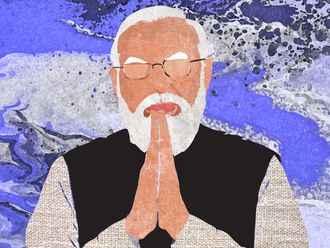
The photos from Mount Everest’s summit were shocking. They showed scores of colourfully costumed climbers gridlocked in the “death zone” just below the summit. Delays caused by overcrowding contributed to several of the 11 deaths on the mountain this year — roughly double last year’s figure — as oxygen tanks, and strength, ran out among people waiting to stand atop the summit or get back down from it. The loss of life, and the chaos evident in the photos, have led to a fresh round of lamentations about the ever-growing numbers of inexperienced adventurers, often part of poorly led expeditions, attempting to stand on the top of the world.
There is surely some truth in these complaints, but there is also something eerily familiar about the coverage. Over the years, reporting about Everest has slipped into a vicious cycle: veneration of its climbers and their goals when things go right, followed by vilification of the culture of Everest when they don’t.
For an influential slice of adventure-oriented publications and TV channels, covering the travails and tragedies of the Everest climbing season has become an annual tradition, akin to watching the French Open or following the Tour de France. Such outlets hype the glory and grandeur of Everest expeditions, and then turn around and lambast the crowds, their incompetence and the Lord of the Flies ruthlessness of climbers in the “death zone” (refusing to help ailing people, lest their own progress be slowed, for example) when summit bids go awry. Once the monsoons end the spring climbing season, which typically shuts down in late May, the cycle starts over again.
A fist-fight broke out in 2013 between elite mountaineers and a group of Sherpas who were putting in ropes to keep more mortal climbers safe, and didn’t want the speedier climbers to pass them.
The media’s love-hate relationship with the mountain was never on clearer display than in a 2006 issue of Outside magazine that featured the cover headline The mess on Everest. The article detailed the deaths of 11 climbers that year, including a British man named David Sharp, who froze to death while at least 40 other climbers stepped past him on their way up and down from the summit. The number of fatalities would have reached 12 if Lincoln Hall, an Australian mountaineer left for dead by his Sherpas when he became ill after reaching the summit, had not somehow awakened and subsequently been rescued by climbers who found him the next day.
Magazines like Men’s Journal and National Geographic, still ping-pong awkwardly between romanticised coverage of Everest feats, such as ultra-runner Kilian Jornet’s reaching the summit twice in a week, without oxygen, in 2017, and hand-wringing about the piles of garbage on the mountain, or the fist-fight that broke out in 2013 between elite mountaineers and a group of Sherpas who were putting in ropes to keep more mortal climbers safe, and didn’t want the speedier climbers to pass them. Meanwhile, mountaineering fans seem to have forgotten that the incident that took the most lives on Everest occurred when a collapsing ice cliff crushed 16 Sherpas in 2014. Not every reporter is there to gawk, and the press hardly invented the idea that reaching 10,000 metres above sea level is one of the ultimate human achievements. Some reporters on site, such as Freddie Wilkinson, who recently profiled the last surviving member of the first expedition to summit Everest, have done incredible work covering it — sometimes alongside pundits who couldn’t find the mountain on a map.
Paradox of Everest’s allure
But given Everest’s glamour, even the most harrowing catastrophe coverage can, paradoxically, increase its allure. Today, as a result of technological advances, climbers no longer need the help of journalists or filmmakers to convey their adventures to the world. There’s a WiFi network on the Nepal side of the mountain, and climbers have had cell service on the summit. Virtually every climber documents his or her adventure through blogs, Facebook pages, Instagram posts and live video, a far cry from the technology available in 1953, when Tenzing Norgay and Edmund Hillary made the first ascent. It took three days for news of their triumph to reach England — just in time for Queen Elizabeth II’s coronation.
It’s possible that footage of long, grim queues to get to the peak, and of climbers left for dead, transmitted in real time, will discourage future dilettantes. But if past experience is any guide, panoramic iPhone images and breathless Snapchat videos will draw still more climbers eager to self-chronicle their adventures. There are few easy solutions for fixing what’s wrong on Mount Everest. Some critics blame the government of Nepal, suggesting that it limit the number of climbing permits for the mountain. (It issued a record 381 this season.) They also say the country’s officials should scrutinise climbers’ fitness and experience. But expecting one of the poorest countries in Asia to turn away some of the world’s wealthiest adventurers, and the revenue they bring, seems unrealistic.
Still, some of the writers vilifying those who flock to the mountain should think harder about the role the media plays in exalting this one experience, above all other possible adventures. Everest may have turned into a circus, but that’s partly because so many of us are watching, and hyping, the show.
— Washington Post
Michael Kodas is the author of High Crimes: The Fate of Everest in an Age of Greed and Megafire: The Race to Extinguish a Deadly Epidemic of Flame.











